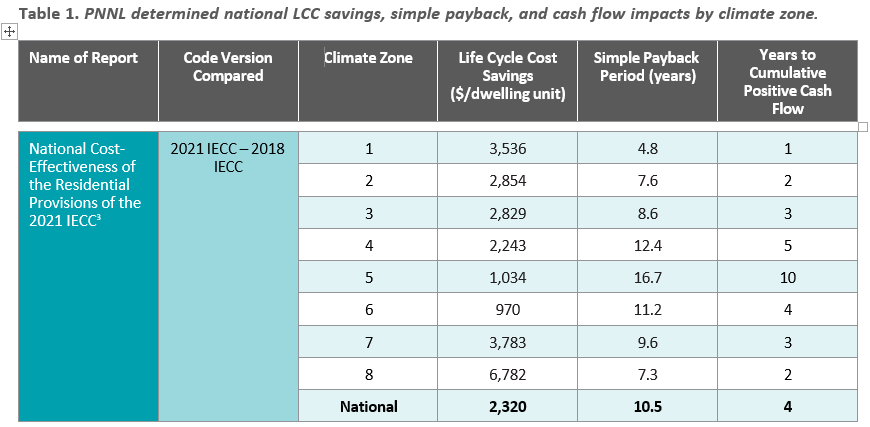

By Dragana Thibault | Fri, January 31, 25
Energy codes play a key role in shaping efficient, affordable, and sustainable housing. NEEP recently published a report, Energy Codes and Affordability, to provide an analysis of how these codes impact homeowners, renters, builders, and policymakers. This blog highlights the report’s findings, offering an understanding of the financial and societal implications of energy codes.
Understanding Cost-Effectiveness
Critics often point to the upfront costs that energy codes may put on new construction as a reason not to adopt modern codes. To investigate these concerns, we reviewed the cost-effectiveness analyses conducted by Pacific Northwest National Laboratory (PNNL) and found that the financial benefits outweigh these initial investments. PNNL’s standardized methodology evaluates metrics such as life cycle costs (LCC), cash flow analysis, and simple payback periods to provide a comprehensive understanding of the financial impacts of energy codes.
Cash flow analysis reveals that energy savings typically offset higher mortgage costs within just four years, making updated codes accessible to most homeowners. LCC, a comprehensive metric, considers the total cost of ownership over 30 years, including construction expenses and operational savings. Homes built to the 2021 International Energy Conservation Code (IECC) show average savings of over $2,300 across their lifespan compared to the 2018 IECC. While simple payback measures the time required for savings to match initial investments, it often overlooks long-term benefits; LCC provides a more complete perspective.
The Value of Stretch Codes
The paper also examines the cost-effectiveness of stretch codes, which exceed the minimum requirements of base energy codes and are an opportunity to achieve greater energy savings and environmental benefits. For instance, Massachusetts’ stretch code allows for use of either fully electric or mixed fuel pathways, however, a study conducted by Massachusetts Department of Energy Resources (DOER) indicates that construction and operating costs are lower when a project is fully electrified by using heat pumps.
This cost analysis includes tax credits and incentives like Mass Save, that further encourage energy efficiency. These programs help offset the cost of adopting advanced measures, making compliance with stretch codes more accessible to builders and homeowners. The NYStretch2020 has demonstrated 10-12 percent greater efficiency than its base code counterpart, with significant savings over a 30-year period. Furthermore, the cost-effectiveness analysis of the Illinois Stretch Code which is an enhancement to the 2021 IECC, demonstrates life-cycle energy cost savings of $2,355 for homebuyers over three decades. These codes offer a model for balancing higher upfront costs with long-term benefits, showcasing how forward-thinking energy policies can address both affordability and sustainability.
Long-Term Impacts Beyond Energy Savings
Energy codes offer benefits beyond just reducing utility bills. They help avoid future costs, improve resilience, and promote equity. They help owners avoid expensive retrofits and panel upgrades. Homes designed with electrification in mind help homeowners to ensure that their homes are ready to integrate modern technologies, such as electric heat pumps and electric vehicles. For example, retrofitting a home for electrification can cost up to four times more than installing the necessary systems during initial construction.
Energy codes also offer critical health benefits. Advanced energy codes improve indoor air quality, reducing health risks like asthma and other respiratory conditions and any associated medical expenses. Additionally, energy-efficient buildings offer better protection during extreme weather events, enhancing both safety and financial resilience for residents.
Energy codes can also alleviate energy burdens, particularly for renters and low-income households. Renters often face higher energy costs due to inefficiencies in rental properties. Energy codes ensure that even rental units meet minimum efficiency standards, lowering utility bills and promoting equitable access to affordable housing.
The Bigger Picture of Housing Affordability
While energy codes are sometimes blamed for increasing housing costs, the report highlights broader market forces as the primary drivers of higher prices. Factors like low housing inventory, rising interest rates, and restrictive zoning laws have a far greater impact. Energy codes, by contrast, deliver long-term savings that enhance affordability and create more sustainable housing options.
At the same time, the residential new construction market often faces a split incentive problem - builders, who do not pay ongoing utility bills, have little motivation to incorporate energy-efficient features that could save future homeowners and renters money. This disconnect underscores why policy solutions are essential. Federal and state programs, such as rebates for energy-efficient new homes and tax credits, help offset upfront costs. Additionally, local governments can support these efforts by aligning zoning laws and streamlining permitting processes to encourage energy-efficient construction. Such measures not only reduce costs but also accelerate the adoption of advanced energy codes.
Moving Forward
The Energy Codes and Affordability report provides a better understanding of how energy codes impact housing costs and opportunities. The report outlines key cost-effectiveness methodologies, offers clarity on stretch code impacts, and identifies incentives and policies that reduce financial barriers. These resources can help policymakers and stakeholders navigate the complexities of energy code implementation while ensuring affordability remains at the forefront.
Policymakers can leverage the tools and data in this report to guide them in reviewing the cost-effectiveness and determining the impacts of updated energy codes. Builders and developers can draw on its findings to communicate the long-term benefits of energy-efficient buildings to customers. Community advocates can use the insights to promote equitable access to energy-efficient housing, particularly for renters and low-income households.
The Energy Codes and Affordability report underscores the importance of adopting and implementing advanced energy codes. By reducing long-term costs, improving health outcomes, and increasing resilience, energy codes contribute to more cost-effective, and future-ready housing. For policymakers, builders, and homeowners, this report offers actionable insights into the different benefits of energy codes. As we navigate the challenges of housing affordability, it’s clear that energy efficiency must remain a cornerstone of cost-effective and resilient buildings.


